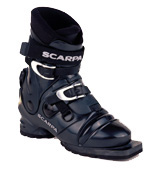"What kind of bindings and boots should I get?"
 There are basically three kinds of bindings used on cross-country skis: three-pin, integral boot/binding systems, and randonee.
There are basically three kinds of bindings used on cross-country skis: three-pin, integral boot/binding systems, and randonee.
You should have a stiff, strong boot with good ankle support for backcountry skiing and Telemarking. Backcountry boots are usually stiffer and sturdier than track boots, and skating boots have a tall plastic cuff for ankle support. Some lift assisted telemarking boots actually have a plastic cuff similar to Alpine downhill boots. Randonee boots are Alpine boots.
-
Three-pin 75mm:

- Most of the Nordic Ski leaders prefer the three-pin binding. It usually consists of a metal or plastic plate that the front of the boot fits into; three holes in front of the toe fit over three pins on the plate, and the top of the plate (or a thick wire) locks down to hold the toe in place. A heel plate keeps the foot in a straight line on the ski, but doesn't hold the heel down. The binding should have a hole to attach a ski retention strap. A runaway ski in the backcountry is just as bad as in a lift assisted area.
- The wire bail can easily pop out and disappear in the snow. It's a good idea to carry one or two spares in your pack. This tendency to pop out under stress is good because it acts as a simple release and can prevent a broken leg.

-
Cable bindings are a type of three-pin binding (used with the same style boot) which hold the toe down with a wedge rather than with pins; the boot is retained by a cable which goes around the heel. Boots and bindings of this style range from light-duty plastic and low-cut boots for track use, to heavy metal bindings (that have a release capability) and stiffer leather and plastic boots which are better for telemarking and carrying loads.
-
The Scarpa T3 available through in the USA through Black Diamond is a popular boot for Telemarking and backcountry touring. The Scarpa website maintained for the United Kingdom has a great deal of useful boot information.
-
Many of the Ski Mountaineers use the release type bindings for steep slopes.
-
Integral systems:
There are three major types of integral systems which are mutually incompatible. These systems have no ability to release under stress and are more dangerous than 3 pin bindings. NNN (New Nordic Norm) is a system in which the three holes in front of the boot toe are replaced by a horizontal metal rod which is locked into the binding by a lever. The heavier-duty NNN-BC (Back Country) system moves the rod under the toes, rather than in front of it, which many find to be more comfortable than either standard NNN or three-pin systems. Both NNN and NNN-BC boots and bindings are made by a variety of companies.
The third system is Salomon's Profil system, a version of which is used by most racers. They also make a backcountry version (not recommended-you could end up with a nasty spiral fracture of the tibia and wait in the snow for a helicopter rescue) Profil, like NNN-BC, has the pivot point under the toes rather than in front of the boot. There is also an older Salomon system, SNS, with the pivot in front. A few other companies make Profil-compatible boots.
All three of these systems partially interlock the sole of the boot with the surface of the binding under the foot, reducing or (for the Profil) eliminating the role of the heel plate. You must use a boot compatible with your particular binding type.
-
Randonee:
These bindings take a standard DIN downhill boot, but have a hinge at the heel which can be released for free-heel climbing, or locked down for downhill skiing. They have release capabilities, like downhill ski bindings.